Interview: Justine Hill in Bushwick
By: Sharon Butler, May 13, 2016
I first saw Justine Hill’s paintings in “Metamodern,” a 2015 group show at Denny Gallery that explored the contemporary fusion of Abstract Expressionism, Minimalism, and Primitivism. Her shaped canvases seem to jump off the wall with their unexpected amalgamation of Modern abstraction, postmodern humor, and the uninhibited brio of old-school graffiti taggers. In a recent studio visit, Hill shared work that she’s making for her forthcoming solo at Denny, and we talked about her process. [Image at top: Paintings on the wall in Justine Hill’s Bushwick studio.]
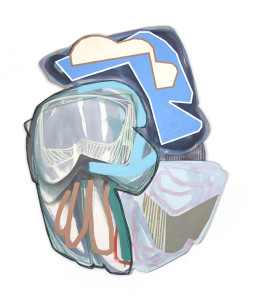 Justine Hill, Assembled, acrylic and pastel on canvas, 60 x 40 inches.
Justine Hill, Assembled, acrylic and pastel on canvas, 60 x 40 inches.
Two Coats of Paint: Your paintings have a freshness and energy–a clarity–that remind me of digital drawing, particularly my favorite, Illustrator. Are your paintings based on digital images?
Justine Hill: I’ve never used Illustrator, but I use Photoshop a lot, not as a way to create the images, but as a way to look at my early drawings and move the paintings forward. I take pictures of rough, hand made sketches, open them in Photoshop and draw on them again. I go back and forth between hand drawn and computer imagery. There’s definitely a digital appearance I guess to the work, but everything always changes on the canvas.
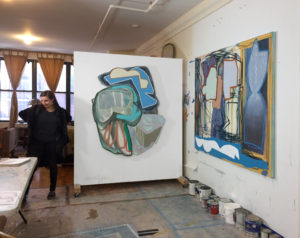 Justine Hill in her studio.
Justine Hill in her studio.
TCOP: Their quirky energy reminds me of the graffiti tags you see around the neighborhood, and your use of shaped canvases seems to reinforce the reference. Walk me through the decisions you made to get here.
JH: I’m still going back and forth between shaped canvases and rectangles. I’ve been working on shaped canvases for about a year, playing with this idea and working on ways to break out of the rectangle. I wanted to engage with the wall. It’s hard to get rectangles to interact with the space around them so I started piecing rectangles together and building composite images from separate paintings, I also tried things like drawing directly on the wall. And then I started to pull shapes out from the rectangles, which is where the cut-outs came from. I always defined myself as a landscape painter and when I started using shape canvases, they began to feel more like creatures. I liked that. I felt as though the forms were exactly the same, but changing the format, once they were separated from their rectangular environment, changed the way they behaved. And they moved around more, they had a freedom.
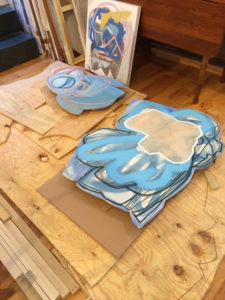 The shaped paintings are cut out of plywood with a jigsaw and covered with canvas.
The shaped paintings are cut out of plywood with a jigsaw and covered with canvas.
TCOP: You think of them as creatures?
JH: Yes…well, I’m not sure how I think of them! I’m still figuring out what I think of them.
TCOP: What are your ideas about color?
JH: I don’t have any specific ideas about color. I basically only pick the color I start with, and then everything, each color, is based on the previous decision–other colors build from there. I use regular acrylics with a lot of pastel and pencil marks mixed in. Drawing is important to me–I like different textures, lines, marks.
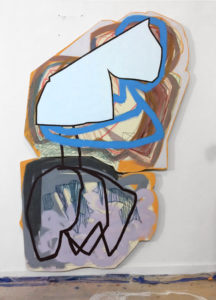 Justine Hill, work on the wall in her studio.
Justine Hill, work on the wall in her studio.
TCOP: What are some of the things you think about when you are deciding if a painting is done? Painters talk a lot, maybe too much, about when a painting is finished, and I feel as if it often has to do not with the image but with the quality of the surface.
JH: I feel that’s true. I find in working with acrylics, I’m very conscious that the surface shouldn’t get too heavy–I don’t want the entire painting to have a thick application of paint. There’s a tenuous balance, and I need to make sure I can finish it before the surface is overworked.
TCOP: Working back and forth with the computer probably helps make decisions off the canvas so you can keep the layers of paint to a minmum?
JH: Yes. The computer allows me to do things without applying more paint. I can try different approaches and make some decisions before putting more paint on the canvas.
TCOP: In essence, working on the computer enables you to hide the process–make it look effortless and inevitable. You start with very crude drawings of shapes, take them into the computer to see where you might take them, and then begin the process of painting. You have a stack of drawings here. How do you select the one you want to work with? What are you looking for in these shapes?
JH: I make a lot of sketches before I select the ones I want to cut out. Often it starts with a shape that I discovered in a previous painting but didn’t use. More recently I’ve been thinking about how the shapes interlock. When building the panels, I use a jigsaw to cut them out, and then stretch canvas over the wood. Piecing together shapes is interesting because it allows me to play even more with borders and edges of things. It’s also a logistical necessity–if I want to make bigger ones, they get too heavy. Breaking them into multiple pieces enables me to move them around by myself. Working this way encourages me to push how the shapes interact, mainly deciding how subtle or jarring the transitions should be.
TCOP: Are these lines made with pastels?
JH: Yes. I’ve been using them a lot lately mainly because I like the speed. When you use paint, you run out and have to reload the brush, but drawing with pastels you can keep going. When it’s fast I draw differently. The marks are different. Speed plays a big part in making these. I don’t mask anything. The lines are all hand drawn even for the more graphic, top shapes. Sometimes I know what I want with the top shapes, and sometimes it’s the last thing that comes to me. The top shapes often reappear in new paintings, but they are all specific in their positions on the canvas–their relationship to the edge.
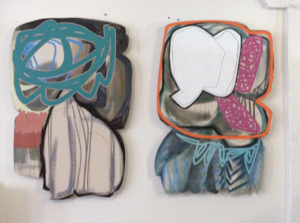 Justine Hill, two smaller paintings on the wall in the studio.
Justine Hill, two smaller paintings on the wall in the studio.
TCOP: Is working digitally an important part of the content of your paintings?
JH: No, I like it because I can work through many ideas, but I don’t consider it part of the content. It lets me keep the images fresh. If a painting gets too heavy, I just restretch the canvas and start again. Sometimes I end up with too many paintings on one canvas–when I get to the middle, I have trouble making a decision, and I make too many moves on one painting. It gets mucky and I hate it. So I start again. I use the computer to help avoid the need to start over, but many times it’s necessary. Another thing I’m thinking about is raw canvas. Can I leave parts of the canvas untouched? It’s hard to for me to do but when I leave parts of the canvas raw, it plays the neutral piece, and that enables white to be more of a dominant shape, not just the background color. There are also paintings I tried to make the raw canvas the foreground shape.
 Justine Hill, a painting on the wall of her studio.
Justine Hill, a painting on the wall of her studio.
TCOP: Do the different types of marks have symbolic meaning?
JH: No, but they have different rules. I don’t paint over marks. Anything that I put down has to be incorporated–except for the top piece, the graphic outline piece, to which that rule doesn’t apply. Everything underneath has to stay as is. There are different behavioral rules for the different marks. If I work too long on a painting this becomes a problem. I also try to avoid modeling form to create the illusion of depth.
TCOP: Are there other artists you are looking at?
JH: Quite a few people are working on shaped canvases now so I follow their work. I liked recent shows byLeah Guadagnoli at 247365 and I love Ruth Root. Also Julia Bland.
TCOP: Is there anything else you want to talk about?
JH: I’m still trying to figure out how to talk about my work! In grad school [Hill is a graduate of the University of Pennsylvania’s MFA program] we talked about why they were paintings, rather than about the paintings themselves. Why I chose to paint rather than to make, say, videos. We never talked about the marks or the content. It was always about the bigger conversation, so I feel as though I don’t have practice talking specifically about painting. I played with other media in grad school–sewing, sculpture and so forth, but I always came back to painting.
“Justine Hill:They Just Behave Differently,” Denny Gallery, LES, New York, NY. May 19 – June 30, 2016.
